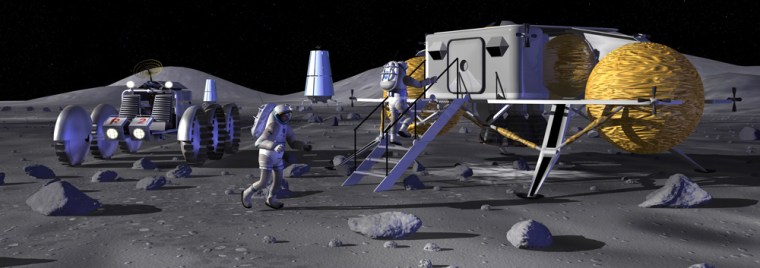NASA announced Monday its strategy and rationale for robotic and human exploration of the moon, determining that a lunar outpost is the best approach to achieve a sustained, human presence there.
The base would be built in incremental steps, starting with four-person crews making several seven-day visits. The first mission would begin by 2020, with the base growing over time, beefed up with more power, mobility rovers and living quarters.
The moon base would eventually support 180-day lunar stays, a stretch of time seen as the best avenue to establish a permanent presence there, as well as prepare for future human exploration of Mars.
Here at the NASA Johnson Space Center, space agency planners detailed a global exploration strategy, outlining the themes and objectives of 21st century lunar exploration and the hardware needed to regain a foothold on the moon.
NASA’s lunar plan also encourages participation by other nations, as well as non-governmental organizations and commercial groups.
Location, location, location
“We’re going to go after a lunar base,” said Scott Horowitz, NASA associate administrator for the Exploration Systems Mission Directorate. The lunar base will be the central theme in NASA’s going back to the moon effort, he said, in preparation to go to Mars and beyond.
As to where on the moon such a post might be positioned—like real estate here on Earth—it’s location, location, location.
“What we’re looking at are polar locations…both the north pole and south pole,” said NASA Deputy Administrator Shana Dale. Picking between the two poles will be done once NASA’s Lunar Reconnaissance Orbiter begins surveying the moon after its launch in October 2008.
One particular area that’s already receiving high marks by NASA’s lunar architecture team is at the South Pole—a spot on the rim of Shackleton Crater that’s almost permanently sunlit.
“It’s also adjacent to a permanently dark region in which there are potentially volatiles that we can extract and use,” said NASA’s Doug Cooke, Deputy Associate Administrator of the Exploration Systems Mission Directorate.
Sphere of economic value
A key technology yet to be defined is a lunar lander—hardware that can be used in piloted or unpiloted mode to develop a capability on the moon more rapidly. “The more you can land the better it is,” Cooke added.
The lander will be designed to touchdown anywhere on the moon, likened to a lunar pickup truck, Horowitz said.
Slideshow 12 photos
Month in Space: January 2014
“The door is wide open in terms of participation by internationals,” Dale noted, and that includes providing power, habitats, mobility on the lunar surface, as well as technology to use the resources on the moon to life off the land.
Dale said that 2007 will feature “extensive dialogue with other countries” about the ways in which they want to participate in exploration activities. “I wouldn’t see it evolving as the same way as the International Space Station,” she told SPACE.com.
NASA’s lunar strategy is evolving from dialogue that has already taken place with 13 other space agencies, Dale explained. The framework for moving forward with other nations will be put in place next year, she said.
A moon outpost would yield tangible science benefits, as well as enlarge the sphere of economic activity beyond low Earth orbit, Horowitz suggested.
International participation
The role of international cooperation in bringing the vision into sharper focus is also being advanced by NASA chief, Mike Griffin.
For example, on December 1, Griffin spoke to the British Royal Society in London, England and pointed to the need for navigation infrastructure on the moon for future explorers and scientists.
Griffin spotlighted the scheduled launch in 2008 of NASA’s Lunar Reconnaissance Orbiter with its laser altimeter and other instruments than can produce an accurate global map of the moon for upcoming expeditions there.
“We’re still formulating our plans for providing communication and navigation for future explorers on the moon, but I can foresee NASA collaborating with other spacefaring nations like the United Kingdom in providing such infrastructure,” Griffin told the British Royal Society.
NASA has nearly 60 on-going space and Earth science missions, Griffin observed, and over half of these missions have some form of international participation.
“Two-thirds of all NASA missions currently under development incorporate international partners. And of course, NASA’s premier human spaceflight program, the development of the International Space Station, is an effort involving some 15 nations,” Griffin said.

